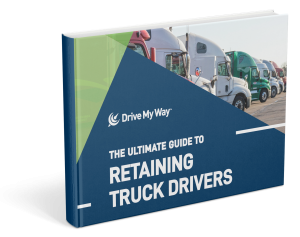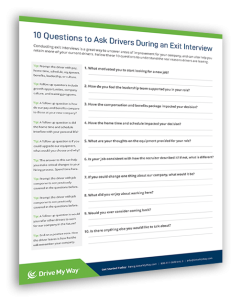 Private fleets are in a strong position when it comes to attracting experienced drivers. Typically, they can offer better compensation, more predictable schedules, and upgraded equipment.
Private fleets are in a strong position when it comes to attracting experienced drivers. Typically, they can offer better compensation, more predictable schedules, and upgraded equipment.
However, with a competitive labor market and ongoing driver shortages, those advantages alone are no longer enough. Many successful fleet managers are rethinking their recruitment and retention strategies to appeal to today’s drivers and reduce costly turnover.
The key to standing out is not just offering a job but offering a career that meets the driver’s financial needs, personal lifestyle, and long-term goals. That means delivering a competitive package built around pay, benefits, culture, and development.
Compensation That Matches the Market
Pay remains one of the top reasons drivers leave or stay. For private fleets, offering competitive compensation is the baseline for attracting the best talent.
Many fleets are shifting to more flexible pay models that include hourly wages, overtime pay, performance bonuses, and clear pay progression. Drivers want transparency about how they are paid and consistency in how their work is rewarded.
It is also important to review pay scales regularly and compare your own practices against the market. Fleets that fail to adjust wages as demand shifts may find themselves losing talent to better-paying carriers.
Benefits That Go Beyond the Basics
Drivers consider benefits a critical part of their overall compensation. Health insurance, retirement contributions, and paid time off are standard, but fleets can gain a competitive edge by expanding into additional wellness and lifestyle benefits.
These might include mental health support, gym reimbursements, pet insurance, or access to financial planning services. Even small additions to a benefits package can signal to drivers that your company values their well-being, both on and off the road.
A Culture Built on Respect and Communication
Drivers who feel heard and respected are more likely to stay. That starts with company culture. Private fleets that foster a positive and supportive environment tend to experience higher retention.
Clear and consistent communication is essential. Dispatchers and managers who treat drivers as partners, rather than simply assigning loads, help create a sense of belonging. Regular check-ins, driver feedback surveys, and team meetings can help identify small issues before they become bigger problems.
Recognition is also a powerful tool. Whether it’s through safety milestone awards, anniversary celebrations, or simple thank-yous, showing appreciation goes a long way in keeping drivers engaged.
Routes and Schedules That Support Work-Life Balance
Predictable home time is one of the top reasons drivers choose a private fleet over other types of trucking jobs. Private fleet managers should prioritize route planning that balances operational efficiency with driver needs. Flexible scheduling options, such as four-day workweeks or regional-only routes, can appeal to both new and experienced drivers.
Offering some level of input into route preferences or time-off scheduling can also improve job satisfaction and reduce burnout.
Career Growth and Training Opportunities
Many drivers are looking for more than a paycheck. They want a career path with room to grow, and an employer that demonstrates their commitment to the growth of their drivers. Fleets that offer advancement opportunities stand out in a crowded field.
This could include structured training programs, internal promotions, or mentorship opportunities that help newer drivers develop their skills. Drivers who see a future with a company are far less likely to leave it.
Private fleets should also consider offering upskilling opportunities such as tanker, hazmat, or doubles endorsements, which can increase driver value and satisfaction. Some fleets even offer tuition reimbursement for further training or business courses.
Smarter Recruiting for Better Results
Retention begins with recruitment. Hiring the right drivers from the start reduces turnover down the line. This means investing in more personalized and strategic recruiting practices.
Fleets can improve hiring outcomes by being upfront about expectations, compensation, and scheduling during the recruitment process. Using digital platforms, mobile applications, and video testimonials from current drivers can help attract the right candidates more effectively.
Some fleets are also refining their onboarding programs to give new drivers a smoother and more supportive transition into the company. A well-structured introduction that includes clear expectations, mentorship, and early engagement can set the tone for stronger driver satisfaction and long-term loyalty.
For more ways to stay ahead of the curve in the transportation industry in 2025, be sure to check out the rest of our Employer Blog posts and connect with us on social media.





 Truck driver retention is a well-documented problem in the trucking industry. Carriers are finding it harder and harder to retain qualified drivers after they’ve joined their fleet. The problem is even worse in the
Truck driver retention is a well-documented problem in the trucking industry. Carriers are finding it harder and harder to retain qualified drivers after they’ve joined their fleet. The problem is even worse in the  If you’re experiencing a high turnover of new drivers, the most important thing to do is figure out why. And the best people to ask? The drivers who are leaving.
If you’re experiencing a high turnover of new drivers, the most important thing to do is figure out why. And the best people to ask? The drivers who are leaving. Everybody wants to feel appreciated at their job, and everybody likes to have tangible goals that they can work towards and achieve. This is the guiding principle behind having awards and incentive programs in the workplace.
Everybody wants to feel appreciated at their job, and everybody likes to have tangible goals that they can work towards and achieve. This is the guiding principle behind having awards and incentive programs in the workplace.  Upgrading the amenities for your fleet of trucks can be a costly venture for organizations. However, carriers should consider that the increased truck driver retention that comes from offering amenities might be worth the initial investment, especially if you have a lot of OTR/Regional drivers.
Upgrading the amenities for your fleet of trucks can be a costly venture for organizations. However, carriers should consider that the increased truck driver retention that comes from offering amenities might be worth the initial investment, especially if you have a lot of OTR/Regional drivers.  Turnover isn’t always a product of a driver simply getting a better pay package somewhere else. Sometimes, drivers leave because they feel they’ve been misled about what the position was before they came onboard.
Turnover isn’t always a product of a driver simply getting a better pay package somewhere else. Sometimes, drivers leave because they feel they’ve been misled about what the position was before they came onboard.  Not every driver is a fit for every carrier, and that’s ok. Recruiting isn’t about finding any driver for the position. It’s about finding the
Not every driver is a fit for every carrier, and that’s ok. Recruiting isn’t about finding any driver for the position. It’s about finding the  Comprehensive CDL Recruitment Solutions
Comprehensive CDL Recruitment Solutions

 It’s no surprise that pay and benefits are the biggest reason that truck drivers leave one position for another. Carriers are finding that they need to go above and beyond from a compensation and benefits perspective, as offering the industry average simply isn’t cutting it anymore.
It’s no surprise that pay and benefits are the biggest reason that truck drivers leave one position for another. Carriers are finding that they need to go above and beyond from a compensation and benefits perspective, as offering the industry average simply isn’t cutting it anymore. Carriers who over-promise and under-deliver are finding that that model for attracting drivers is no longer solid. Truck drivers have more options than ever before when it comes to which carrier they can drive for, so being honest and transparent are the best things carriers can do during the interview and hiring process if they want to recruit top talent.
Carriers who over-promise and under-deliver are finding that that model for attracting drivers is no longer solid. Truck drivers have more options than ever before when it comes to which carrier they can drive for, so being honest and transparent are the best things carriers can do during the interview and hiring process if they want to recruit top talent.  As the saying goes, employees don’t leave the company. Employees leave the people at the company. If a truck driver finds themselves working with a dispatcher they truly dislike, it won’t be long before they start looking for a different opportunity.
As the saying goes, employees don’t leave the company. Employees leave the people at the company. If a truck driver finds themselves working with a dispatcher they truly dislike, it won’t be long before they start looking for a different opportunity. Now more than ever, the ability for carriers to retain truck drivers is key. As the labor market
Now more than ever, the ability for carriers to retain truck drivers is key. As the labor market The last thing a driver wants is a carrier that over-promises and under-delivers. Before posting a job, carriers should take the time to l
The last thing a driver wants is a carrier that over-promises and under-delivers. Before posting a job, carriers should take the time to l Sometimes it takes a carrier posting a job advertisement on Facebook for them to find out that their current drivers are unsatisfied. Maybe their pay is too low, their benefits aren’t desirable, or the carrier over-promises and under-delivers.
Sometimes it takes a carrier posting a job advertisement on Facebook for them to find out that their current drivers are unsatisfied. Maybe their pay is too low, their benefits aren’t desirable, or the carrier over-promises and under-delivers.  Instead of constantly investing in lofty sign-on bonuses to attract new drivers, carriers should implement referral bonus programs and
Instead of constantly investing in lofty sign-on bonuses to attract new drivers, carriers should implement referral bonus programs and 

 As truck driver retention continues to be an issue across the industry, companies should take every opportunity to show their drivers that they’re appreciated for the work they do day in and day out. One of the best ways to show your carrier’s appreciation is to take time to celebrate a driver’s work anniversary.
As truck driver retention continues to be an issue across the industry, companies should take every opportunity to show their drivers that they’re appreciated for the work they do day in and day out. One of the best ways to show your carrier’s appreciation is to take time to celebrate a driver’s work anniversary.  There’s no substitute for cash. Rewarding drivers who’ve stayed on with your carrier with a
There’s no substitute for cash. Rewarding drivers who’ve stayed on with your carrier with a  Aside from cash, gift cards are another great option. You could go with something universal that would work for almost anyone, like an Amazon or Target gift card, or you could go for something a little more personalized.
Aside from cash, gift cards are another great option. You could go with something universal that would work for almost anyone, like an Amazon or Target gift card, or you could go for something a little more personalized.  Gift cards and cash are great, but to certain drivers, there’s a chance they’ll come across as a little impersonal. Instead,
Gift cards and cash are great, but to certain drivers, there’s a chance they’ll come across as a little impersonal. Instead,  It’s hard to overstate the value of an unexpected day off. Rewarding loyal drivers with a surprise extra day of vacation or PTO can be the best way to celebrate, especially if you know the driver has a family/children they can enjoy their time off with.
It’s hard to overstate the value of an unexpected day off. Rewarding loyal drivers with a surprise extra day of vacation or PTO can be the best way to celebrate, especially if you know the driver has a family/children they can enjoy their time off with.
 The number one reason that truck drivers end up declining a job is because they’ve already accepted a different offer that reached them first. This is why quickly moving your candidates through the recruiting pipeline is so important.
The number one reason that truck drivers end up declining a job is because they’ve already accepted a different offer that reached them first. This is why quickly moving your candidates through the recruiting pipeline is so important. Time isn’t the only way to measure efficiency in recruiting. Cost per hire or CPH is an essential metric that measures how
Time isn’t the only way to measure efficiency in recruiting. Cost per hire or CPH is an essential metric that measures how  Gone are the days of putting up some flyers and placing your job ad in the newspaper. Digital is king now, with most interested drivers coming from Google searches,
Gone are the days of putting up some flyers and placing your job ad in the newspaper. Digital is king now, with most interested drivers coming from Google searches,  The above metrics take into account truck driver recruiting efforts before the job starts. But those aren’t the only ones you should be looking at. Connecting recruiting efforts with the quality of your hires and their first-year job performance can help you see if your recruiting team is going after the right candidates.
The above metrics take into account truck driver recruiting efforts before the job starts. But those aren’t the only ones you should be looking at. Connecting recruiting efforts with the quality of your hires and their first-year job performance can help you see if your recruiting team is going after the right candidates.  Measuring driver satisfaction is one of the secrets to measuring recruiting success and maximizing driver retention. Drivers and fleets are both looking for a strong match. If drivers aren’t happy with their carrier, it’s only a matter of time before they start looking elsewhere. Given the current state of the trucking industry, your fleet can’t afford to lose a driver after already spending resources on hiring and onboarding.
Measuring driver satisfaction is one of the secrets to measuring recruiting success and maximizing driver retention. Drivers and fleets are both looking for a strong match. If drivers aren’t happy with their carrier, it’s only a matter of time before they start looking elsewhere. Given the current state of the trucking industry, your fleet can’t afford to lose a driver after already spending resources on hiring and onboarding.  At this point, the trucking shortage has become the normal state of things. It’s widely understood that the demand for truck drivers is much higher than the supply of drivers looking for jobs. Because of this, trucking companies are doing whatever they can to keep current drivers happy and bring new ones onboard. This includes pay increases, newer trucks and equipment, increased home time, and more.
At this point, the trucking shortage has become the normal state of things. It’s widely understood that the demand for truck drivers is much higher than the supply of drivers looking for jobs. Because of this, trucking companies are doing whatever they can to keep current drivers happy and bring new ones onboard. This includes pay increases, newer trucks and equipment, increased home time, and more.

 Being a pet friendly trucking company is more than just a perk for some drivers. Offering a pet rider program strengthens company culture, retention, and recruiting. Ultimately, pet programs are about driver satisfaction and happiness and should be considered part of an overarching retention strategy. With strong marketing that displays a positive company culture, pet programs can also bolster driver recruitment efforts.
Being a pet friendly trucking company is more than just a perk for some drivers. Offering a pet rider program strengthens company culture, retention, and recruiting. Ultimately, pet programs are about driver satisfaction and happiness and should be considered part of an overarching retention strategy. With strong marketing that displays a positive company culture, pet programs can also bolster driver recruitment efforts.  Offering a pet program is a great way to boost driver happiness and
Offering a pet program is a great way to boost driver happiness and 



